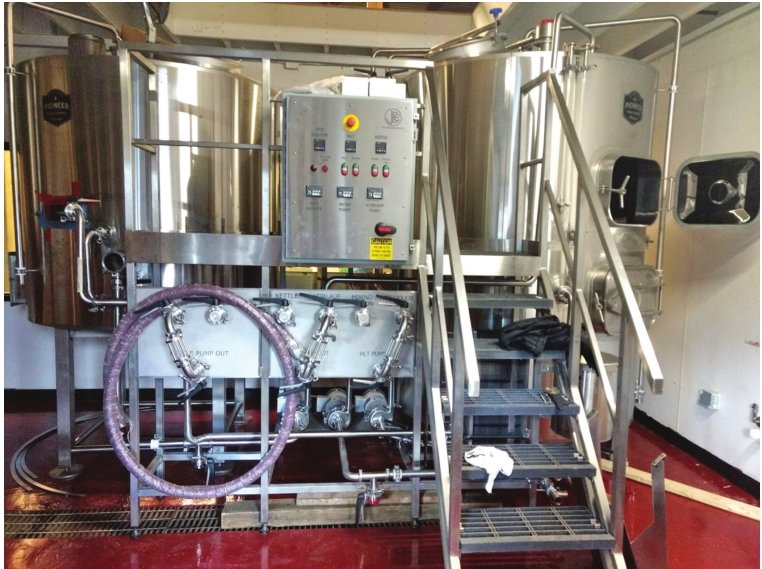
If you’ve ever been into Old Nation Brewery’s pub, you know that it is a great environment to enjoy a brew in. But if you’re curious like me, it can be hard to keep your eyes from wandering through the small windows and doors at the back of the pub into the large production area behind them.
Through those windows and behind those doors are over a dozen massive stainless steel tanks, a bottling/canning machine, a device that puts beer into kegs and a labeling machine. By far, Old Nation isn’t Michigan’s largest brewery, but its production facility is quite impressive, cranking out about 20,000 barrels per year.
This past month, the 3-year old Williamston-based brewery added to its impressive production facility with a new pilot system from Pioneer Tank and Vessel out of Portland, Oregon. I sat down with Mark Logusz from Old Nation Brewery to talk about what a pilot system is, how it benefits them and what they are going to do with it.
Technically, a pilot system is just a smaller version of the larger brewing system described above. Rather than producing 20,000 barrels per year, this smaller system has the capacity to produce about 2500 barrels per year. But why have a smaller separate brewing system?
“There are really two main reasons for having a pilot system, the first being the most fun: experimentation,” explained Logusz.
Like in cooking, making beer requires ingredients. When it comes to creating different recipes, buying new ingredients and experimenting with them during the beer making process can get pricy if they don’t work out.
“Being able to take risks and chances at a smaller scale and then create a path in which we can get feedback. We can either tweak the beer, dump it, or leave it alone and scale it without losing too much money on wasted ingredients.”
The second benefit to having a smaller pilot system in their production facility is that it allows Old Nation to create appropriate amounts of beers for what they are selling.
“We’ve got beers that our locals really dig that we want to keep on tap at the pub. That’s an appropriate volume to make as opposed to an 80 barrel batch of it,” said Logusz.
Old Nation produces two to three beers on a larger scale for distribution purposes — their M-43 beer and either their Boss Tweed Double IPA, or Cart Horse (formerly known as Boxer).
Logusz said that with the larger system, it is most economical to produce beer at full capacity. If the system can make 20,000 barrels, it should be making 20,000 barrels to make maximum profit from that production. Because the rest of Old Nation’s beers (about 14 in total) aren’t distributed as widely and are considered pub-only, they don’t need to produce those beers on such a large scale.
“It lets us play. The guys have been making the same two or three beers for years straight. From a production prospective that’s great,” said Logusz. “But these guys are artists, they want to have that ability to come in here and mess around, mess up and be creative.”
But while Old Nation’s pilot system has the capacity to brew 2500 barrels of beer per year that doesn’t necessarily mean it will. Because it can be used for experimentation, some of the beer that that system produces might not be drinkable. Also, because it is used to make smaller batches of pub-only beer, the demand is much less for the beers that it will produce.
“The big system is meant to be maximized, to run all the time. This is meant to be run a little bit more on-demand,” said Logusz.
According to Logusz, it’s pretty common for breweries to have pilot systems for the same reasons that Old Nation invested in one. The scale or size of each brewery’s pilot system, however, can fluctuate greatly depending on the size and scale of the brewery.
“I think Bell’s pilot system is probably as big as our main system,” he said.
Logusz used Old Nation’s 5-acre Cream Ale as an example of a beer that they wouldn’t brew with their larger system now that they have the smaller one.
“There are lots of cream ales on the market already, and it’s not necessarily something that we would can and ship out,” he explained.
“But, it’s a great beer to have on our menu to round it out. When people come here they want to try something that’s pub only, so its good to have choices. The problem is for me to make 80 barrels of cream ale, it would sit here for years. That’s a lot of cream ale. That’s why a system like this is perfect.”
Support City Pulse - Donate Today!
Comments
No comments on this item Please log in to comment by clicking here